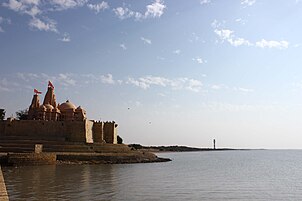
Bhuj is a city and the headquarters of Kutch district in the Indian state of Gujarat.

Anjar is a town, township and municipality of the Kachchh district (Kutch)in the state of Gujarat, India. Founded in 650 AD, Anjar is a culturally diverse town of historic importance in the region. It is home to several historic religious temples, including the Jesal-Toral Shrines built in honour of a fourteenth century couple, whose lives inspired works of art and cinema. The town was devastated by several earthquakes, including the 1819 Rann of Kutch earthquake and 2001 Gujarat earthquake. In recent years, Anjar has become a hub of manufacturing activity.
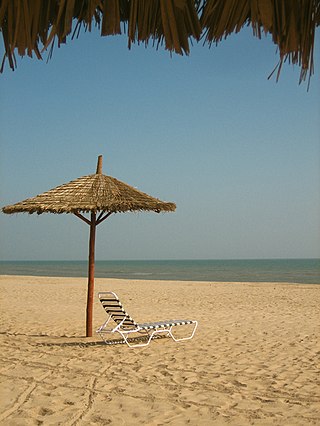
Mandvi is a beach town with municipality in the Kachchh district (Kutch) in the Indian state of Gujarat. It was once a major port of the region and summer retreat for Maharao (king) of the Cutch State. The old city was enclosed in the fort wall and remains of the fort wall can still be seen. The city has a four-hundred-year-old ship building industry which is still functional and dhows, a type of wooden ship, are still made. Mandvi Municipality's 36 Seat Of 9 Ward.

Lakhpat is a town in Kachchh district in the Indian state of Gujarat located at the mouth of the Kori Creek. The town is enclosed by 7km-long, 18th century fort walls.
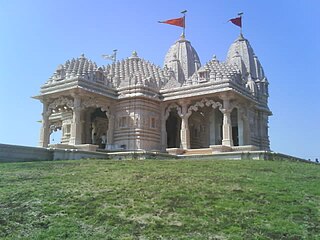
Mundra is a census town and a headquarter of Mundra Taluka of Kachchh district in the Indian state of Gujarat. Founded in about the 1640s, the town was an important mercantile centre and port throughout its history. Mundra Port is the largest private port in India.
Dhinodhar Hills are located near Nani Aral village, in Nakhatrana Taluka, Kutch District, Gujarat, in India. Dhinodhar Hill is a tourist and pilgrimage spot.
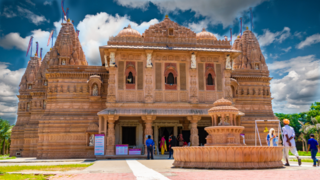
Bhadresar or Bhadreshwar is a village in Mundra Taluka, Kutch district of Gujarat, India. It is about 27 km from Taluka headquarters Mundra and barely a kilometer away from the seashore.

Narayan Sarovar or Narayansar is a village and place of pilgrimage for Hindus on the Kori Creek. It is located in Lakhpat taluka of Kutch district in the Indian state of Gujarat. The ancient Koteshwar temple lies 4 km away, towards the north-west. The temple is classified among the 108 Abhimana Kshethram of Vaishnavate tradition.

Mata no Madh is a village in Lakhpat Taluka of Kutch district, Gujarat, India. The village lies surrounded by hills on both banks of a small stream and has a temple dedicated to Ashapura Mata, the household deity of former Jadeja rulers of kutch State. She is also considered patron deity of Kutch. The village is located about 105 km from Bhuj, the headquarters of Kutch district.
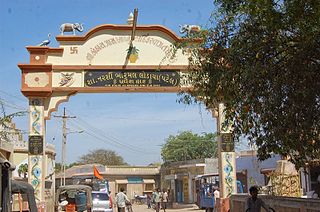
Kothara is a village and a Jain pilgrimage center located in Abdasa Taluka of Kutch district of Gujarat, India.
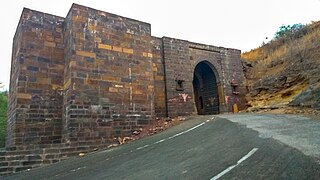
Kanthkot fort is located near Kanthkot village, Bhachau Taluka of Kutch, Gujarat.
Bhuvad is a village of Ahir [Zaru] And Rathod or rathore Rajput Kshatriya in Anjar Taluka of Kutch district of Gujarat, India.

Bhadreshwar Jain Temple, also known as Vasai Jain Temple, is a historical importance located in Bhadreshwar village of Mundra Taluka, Kutch, Gujarat, India.
Gedi is a village near Rapar of Kutch district of Gujarat, India.

Gundiyali is a village near Mandvi of Kutch district of Gujarat, India.
Rav is a village of three hamlets; Rav Moti, Rav Nani and Temple; in an open plain, located nineteen miles from Chobari, in Rapar Taluka of Kutch district of Gujarat, India.
Sikra is a village in Bhachau Taluka of Kutch district of Gujarat, India.
Vinzan or Vinjhan is a village in Abdasa Taluka in Kutch district of Gujarat, India.
Patgadh or Vagham Chavdagadh was a historical town and capital of western Kutch during rule of Chawda dynasty. The ruins of the town is located in Lakhpat Taluka in Kutch district of Gujarat, India. The village is on the west bank of Little Rann of Kutch.

The Shantinath Jain temple is located in Kothara of Kutch district, Gujarat, India. The temple is dedicated to Shantinatha and is an important place of pilgrimage for the followers of Jainism.







